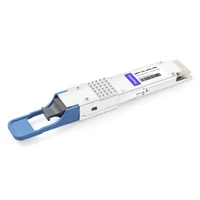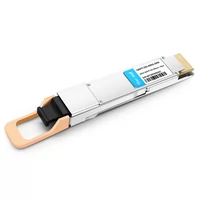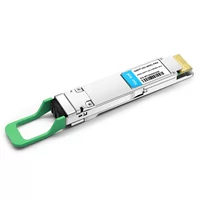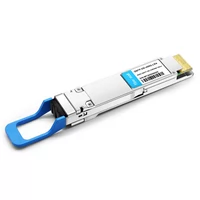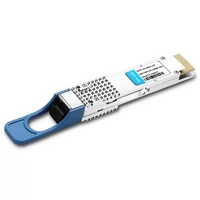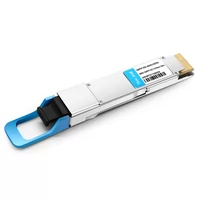Two common package types of 400G transceivers are OSFP and QSFP-DD. The optical module encapsulated by OSFP has good thermal performance and can be expanded to 800G, but its volume is large. The optical module in the QSFP-DD package is simpler and compatible. For the 400G optical module, the electrical signals of the interface between OSFP/QSFP-DD and the host are 8x50G/PAM4, that is, they all adopt the PAM4 modulation mode. This paper will introduce PAM4 modulation mode and its application in the 400G transceiver.
Table of Contents
Toggle1. What is PAM4 in optical communication?
PAM4(Pulse Amplitude Modulation 4-Level) is now a very important and fundamental technology in the field of optical communication. Before understanding PAM4, it is necessary to know another more basic signal modulation technology – NRZ(Non-Return-to-Zero), also called PAM2(2- level). NRZ is a digital logic signal that uses both high and low signal levels to represent the transmitted information. With unipolar non-return-to-zero codes, “1” and “0” correspond to positive and zero levels, or negative and zero levels, respectively. Bipolar non-zero codes, where “1” and “0” correspond to a positive level and an equivalent negative level respectively.
The term “non-zero” does not mean that there is no “0”, but that the signal does not need to return to zero level after each bit of data is transmitted (obviously, NRZ saves bandwidth compared to RZ). In optical module modulation, we use the power of the laser to control the “0” and “1”. In simple terms, it means that when the actual emitted optical power is greater than a certain threshold, it is a “1”; if it is less than a certain threshold, it is a “0”.
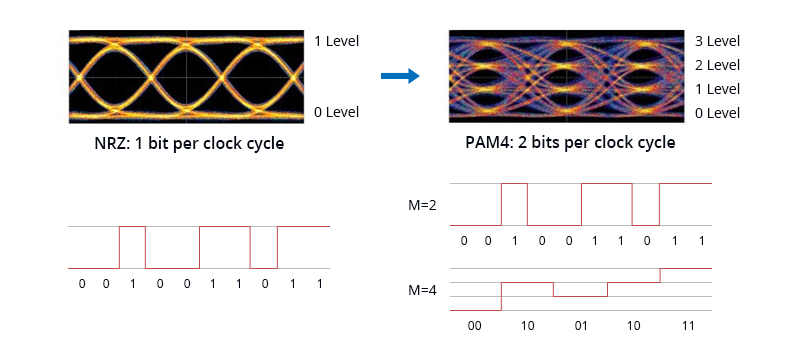
As bandwidth demands continue to increase, we need to find ways to increase the amount of logical information transmitted per unit time, and PAM4, a more advanced modulation technology, appears. It uses four different signal levels for signal transmission. It can double the logical information represented by a single symbol cycle from 1 bit of NRZ to 2 bits. For example, after a 25G EML chip is modulated by PAM4, it can be made into a single channel 50G PAM4 optical module. Click this article to know more about NRZ and PAM4.
2. Why does 400G Ethernet adopt PAM4 technology?
At first, the IEEE association did not consider PAM4 technology when formulating a new generation of 200G/400G interface standard, such as 400GBASE-SR16, but adopted NRZ technology to achieve 400G transmission rate through 16x25Gbps parallel channels. However, the scheme requires a large number of optical fibers, which is not economical and feasible, and the time margin of transceiver chip, transmission link loss and size of the scheme can not meet the demands of 400G Ethernet.
Therefore, when the IEEE association formulated the 802.3bs standard, it proposed that PAM4 replace NRZ. After in-depth research on the characteristics and parameter tests of the PAM4 signal, the proposal was finally passed. Subsequently, the 400GBASE-LR8/400GBASE-FR8 interface standard based on PAM4 technology was promulgated, becoming the first 400G interface standard. The interface standard adopts 8x50Gbps PAM4 technology to realize 400G transmission. It no longer needs 16x25G channels to realize 400G transmission like NRZ. In this way, it can not only save the cost of optical fiber but also reduce the link loss.
3. Application of PAM4 in 400G transceiver: multi-mode vs single-mode
PAM4 is the main modulation mode of the 400G QSFP-DD optical module, which has two types: multi-mode and single-mode. The electrical port side of the 400G transceiver based on PAM4 modulation is modulated by 8x50G PAM4, while the optical port side has two modulation types: 8x50G PAM4 and 4x100G PAM4.
1) Multi-mode 400G transceiver
Common 400G multi-mode optical modules are SR8 and SR4.2 interfaces, all using 8x50G PAM4 modulation.
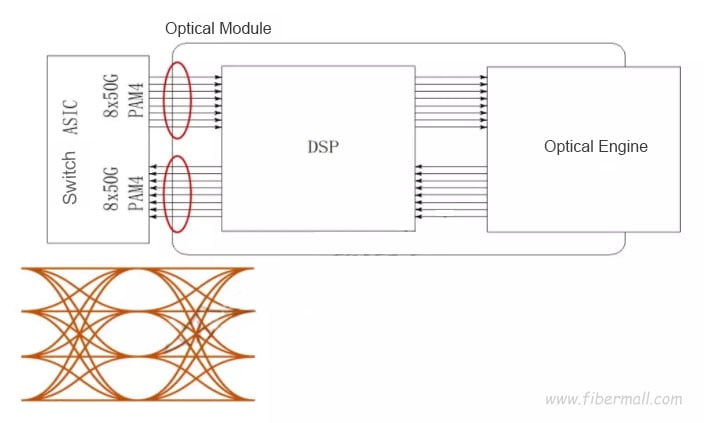
- 400G SR8: “SR” means using multi-mode optical fiber to transmit 100m distance, while “8” means having 8 optical channels. When each optical channel operates with 50G PAM4, a total of 16 optical fibers (8 TX and 8 Rx) are required. 400G SR8 optical module can connect 8 pairs of optical fibers by using MPO-16 connector or MPO-24 connector.
- 400G SR4.2: “SR” refers to using multi-mode optical fiber to transmit 100m distance, “4” means there are 4 optical channels, while “2” means each channel has two wavelengths. 400G SR4.2 module uses MPO-12 connector, each optical channel operates with 2x50G PAM4, and a total of 8 optical fibers are required. The wavelengths are bidirectional and multiplexed. The main advantage of SR4.2 is that it can continue to use the existing installed optical fiber resources.
| Module Type | Transmission Distance | Fiber Type | Optical Interface | Fiber Cores | Wavelength | Modulation |
| 400G SR8 | 100m | Parallel Multi-mode | MPO-16(APC) or MPO-24(PC) | 16 | 850nm | 50G PAM4 |
| 400G SR4.2 | 100m | Parallel Multi-mode | MPO-12(APC) | 8 | 850nm/910nm | 50G PAM4 |
2) Single-mode 400G transceiver
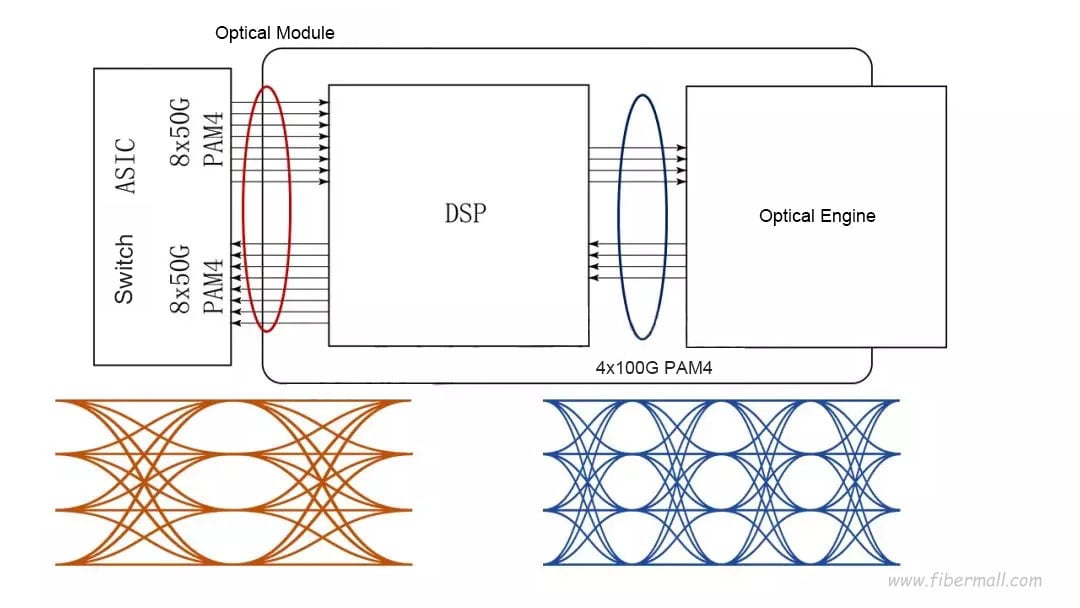
Single-mode 400G optical transceiver can be divided into two groups. One group of the optical port side is modulated with 8x50G PAM4, and the other group is modulated with 4x100G PAM4. Both methods use DSP as CDR (no analog CDR is established) or a combination of Gearbox and CDR. The difference lies in the signal transmission rate on the line side and the number of lasers used.
- Single-mode 400G transceiver based on 8×50G PAM4
There are three common types of 400G optical modules in this modulation mode: FR8, LR8, and 2xFR4.
400G FR8 and 400G LR8 are the earliest available 400G single-mode interfaces. “8” means 8 wavelengths are used, and each wavelength operates with 50G PAM4. “FR” means 2km transmission, “LR” means 10km transmission. 8 wavelengths are multiplexed into one optical fiber, and FR8 and LR8 optical modules use duplex LC optical interfaces.
The 2xFR4 400G optical module uses 8 lasers, but is divided into two groups of 4 wavelengths (according to the 200G FR4 standard). The two groups are multiplexed into the optical fiber respectively, and the optical module provides 2x200G signals on the two CS connectors.
| Module Type | Transmission Distance | Fiber Type | Optical Interface | Fiber Cores | Wavelength | Modulation |
| 400G 2xFR4 | 2km | SMF | 2xCS | 4 | 4 (CWDM4) | 50G PAM4 |
| 400G FR8 | 2km | SMF | LC | 2 | 8 (LWDM) | 50G PAM4 |
| 400G LR8 | 10km | SMF | LC | 2 | 8 (LWDM) | 50G PAM4 |
However, there are trade-offs when using an 8x50G solution. On the one hand, they provide improved link budgets in some cases, but on the other hand, the total laser cost per module is higher and the optical packaging is more complex, resulting in lower output and higher production cost. In contrast, the 4x100G module has lower power consumption and simpler heat treatment ability. Therefore, the 4x100G solution is more popular.
- Single-mode 400G transceiver based on 4×100G PAM4
4x100G optical modules are the focus of the current market. Their line side uses four channels with 100G PAM4. Here, we can divide these optical modules into “multi-fiber” and “dual-fiber”. The key components of these optical modules are DSP with Gearbox function, including DR4, FR4 and LR4.

400G DR4: in the 400G DR4 optical module, DSP converts 8x50G PAM4 electrical signal into 4x100G PAM4, and then transmits it to the optical engine. At the same time, DSP acts as CDR, the working wavelength of each channel is 1310nm, and each channel requires one fiber, so a total of 8 fibers are required.
400G FR4 and LR4: the basic functions of DSP are the same in FR4 and LR4 optical modules as in DR4, but now four wavelengths (CWDM4) are used instead of four 1310nm signals, and a multiplexer is added to combine these CWDM signals. In this way, the number of optical fibers required for FR4/LR4 is reduced to 2 (TX + Rx), and duplex LC optical ports are adopted.
| Module Type | Transmission Distance | Fiber Type | Optical Interface | Fiber Cores | Wavelength | Modulation |
| 400G DR4 | 500m | PSM/SMF | MPO-12(APC) | 8 | 1 (1310nm) | 100G PAM4 |
| 400G FR4 | 2km | SMF | LC | 2 | 4 (CWDM4) | 100G PAM4 |
| 400G LR4 | 10km | SMF | LC | 2 | 4 (CWDM4) | 100G PAM4 |
To summary, with the advent of big data and cloud computing, the rapid growth of traffic forces signal modulation technology to develop in a more complex direction. As the most efficient modulation technology at present, PAM4 has become the inevitable trend of the development of the 400G high-speed optical module. In the future, considering the cost, the way of realizing 400G transmission with 4-channel optical signals may become the mainstream. At the same time, the electrical port of the optical module may be gradually upgraded to the form of 4x100G PAM4, the Gearbox chip is omitted, so as to save power consumption and cost.
Related Products:
-
 QSFP-DD-400G-DR4 400G QSFP-DD DR4 PAM4 1310nm 500m MTP/MPO SMF FEC Optical Transceiver Module
$400.00
QSFP-DD-400G-DR4 400G QSFP-DD DR4 PAM4 1310nm 500m MTP/MPO SMF FEC Optical Transceiver Module
$400.00
-
 QSFP-DD-400G-SR8 400G QSFP-DD SR8 PAM4 850nm 100m MTP/MPO OM3 FEC Optical Transceiver Module
$149.00
QSFP-DD-400G-SR8 400G QSFP-DD SR8 PAM4 850nm 100m MTP/MPO OM3 FEC Optical Transceiver Module
$149.00
-
 QSFP-DD-400G-FR4 400G QSFP-DD FR4 PAM4 CWDM4 2km LC SMF FEC Optical Transceiver Module
$500.00
QSFP-DD-400G-FR4 400G QSFP-DD FR4 PAM4 CWDM4 2km LC SMF FEC Optical Transceiver Module
$500.00
-
 QSFP-DD-400G-LR4 400G QSFP-DD LR4 PAM4 CWDM4 10km LC SMF FEC Optical Transceiver Module
$600.00
QSFP-DD-400G-LR4 400G QSFP-DD LR4 PAM4 CWDM4 10km LC SMF FEC Optical Transceiver Module
$600.00
-
 QSFP-DD-400G-LR8 400G QSFP-DD LR8 PAM4 LWDM8 10km LC SMF FEC Optical Transceiver Module
$2500.00
QSFP-DD-400G-LR8 400G QSFP-DD LR8 PAM4 LWDM8 10km LC SMF FEC Optical Transceiver Module
$2500.00
-
 QSFP-DD-400G-XDR4 400G QSFP-DD XDR4 PAM4 1310nm 2km MTP/MPO-12 SMF FEC Optical Transceiver Module
$580.00
QSFP-DD-400G-XDR4 400G QSFP-DD XDR4 PAM4 1310nm 2km MTP/MPO-12 SMF FEC Optical Transceiver Module
$580.00

